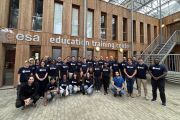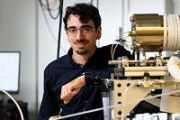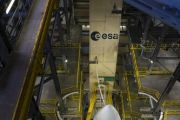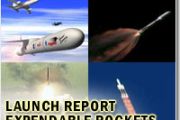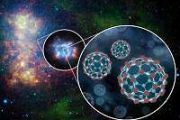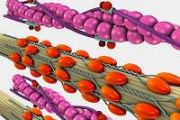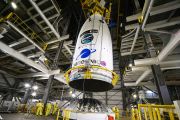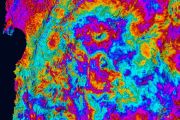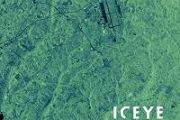
Copernical Team
UAH researcher unveils new map of Milky Way galaxy in atomic hydrogen
 Dr. Sukanya Chakrabarti, the Pei-Ling Chan Endowed Chair at The University of Alabama in Huntsville (UAH), a part of The University of Alabama System, has co-authored a paper that uses young stars to develop a more accurate map of the outer gas disk of the Milky Way galaxy.
The findings are being presented at the 246th meeting of the American Astronomical Society in Anchorage, Alaska, on J
Dr. Sukanya Chakrabarti, the Pei-Ling Chan Endowed Chair at The University of Alabama in Huntsville (UAH), a part of The University of Alabama System, has co-authored a paper that uses young stars to develop a more accurate map of the outer gas disk of the Milky Way galaxy.
The findings are being presented at the 246th meeting of the American Astronomical Society in Anchorage, Alaska, on J Solar Orbiter delivers first clear look at the Sun's poles from deep space
 Thanks to a newly inclined orbit, ESA's Solar Orbiter spacecraft has captured the first-ever images of the Sun's poles taken from outside the ecliptic plane. This novel vantage point marks a breakthrough in solar research, offering new insights into the Sun's magnetic field, solar cycles, and space weather dynamics.
Historically, solar imaging has been confined to the ecliptic plane-where
Thanks to a newly inclined orbit, ESA's Solar Orbiter spacecraft has captured the first-ever images of the Sun's poles taken from outside the ecliptic plane. This novel vantage point marks a breakthrough in solar research, offering new insights into the Sun's magnetic field, solar cycles, and space weather dynamics.
Historically, solar imaging has been confined to the ecliptic plane-where Earth-based telescopes offer a fresh look at cosmic dawn
 For the first time, scientists have used Earth-based telescopes to look back over 13 billion years to see how the first stars in the universe affect light emitted from the Big Bang.
Using telescopes high in the Andes mountains of northern Chile, astrophysicists have measured this polarized microwave light to create a clearer picture of one of the least understood epochs in the history of t
For the first time, scientists have used Earth-based telescopes to look back over 13 billion years to see how the first stars in the universe affect light emitted from the Big Bang.
Using telescopes high in the Andes mountains of northern Chile, astrophysicists have measured this polarized microwave light to create a clearer picture of one of the least understood epochs in the history of t Decades-old mystery of AlCl dipole moment resolved
 In a study that closes a long-standing knowledge gap in fundamental science, researchers Boerge Hemmerling and Stephen Kane at the University of California, Riverside, have successfully measured the electric dipole moment of aluminum monochloride (AlCl), a simple yet scientifically crucial diatomic molecule. Their results, published in Physical Review A, have implications for quantum technologie
In a study that closes a long-standing knowledge gap in fundamental science, researchers Boerge Hemmerling and Stephen Kane at the University of California, Riverside, have successfully measured the electric dipole moment of aluminum monochloride (AlCl), a simple yet scientifically crucial diatomic molecule. Their results, published in Physical Review A, have implications for quantum technologie Unexpected Dust Patterns Found on Uranus Moons Confound Scientists
 Scientists using NASA's Hubble Space Telescope set out to detect radiation-induced surface changes on Uranus' largest moons but uncovered a different phenomenon altogether.
The team had hypothesized that charged particles from Uranus' magnetosphere would darken the trailing hemispheres of its four major moons-Ariel, Umbriel, Titania, and Oberon-due to constant bombardment. These moons are
Scientists using NASA's Hubble Space Telescope set out to detect radiation-induced surface changes on Uranus' largest moons but uncovered a different phenomenon altogether.
The team had hypothesized that charged particles from Uranus' magnetosphere would darken the trailing hemispheres of its four major moons-Ariel, Umbriel, Titania, and Oberon-due to constant bombardment. These moons are ESA Flyeye telescope begins full sky survey for asteroid detection
 The European Space Agency's Flyeye telescope has officially commenced operations, capturing its first celestial images and marking a significant advancement in the detection of near-Earth asteroids and comets.
Engineered with a unique compound-eye-inspired design, Flyeye was developed by ESA and OHB Italia to monitor a sky area over 200 times the size of the full Moon in a single shot. Thi
The European Space Agency's Flyeye telescope has officially commenced operations, capturing its first celestial images and marking a significant advancement in the detection of near-Earth asteroids and comets.
Engineered with a unique compound-eye-inspired design, Flyeye was developed by ESA and OHB Italia to monitor a sky area over 200 times the size of the full Moon in a single shot. Thi Why the moon shimmers with shiny glass beads
 The Apollo astronauts didn't know what they'd find when they explored the surface of the moon, but they certainly didn't expect to see drifts of tiny, bright orange glass beads glistening among the otherwise monochrome piles of rocks and dust.
The beads, each less than 1 mm across, formed some 3.3 to 3.6 billion years ago during volcanic eruptions on the surface of the then-young satellite
The Apollo astronauts didn't know what they'd find when they explored the surface of the moon, but they certainly didn't expect to see drifts of tiny, bright orange glass beads glistening among the otherwise monochrome piles of rocks and dust.
The beads, each less than 1 mm across, formed some 3.3 to 3.6 billion years ago during volcanic eruptions on the surface of the then-young satellite PLD Space advances MIURA 5 launch capability with TEPREL C engine tests
 PLD Space has reached a critical milestone in the development of its MIURA 5 orbital launcher by completing integrated testing of its TEPREL-C rocket engines. This progress marks a significant step toward the start of the engine's flight qualification campaign, which is slated to begin at the end of June.
The Spanish aerospace company emphasizes propulsion as the foundation of its technolo
PLD Space has reached a critical milestone in the development of its MIURA 5 orbital launcher by completing integrated testing of its TEPREL-C rocket engines. This progress marks a significant step toward the start of the engine's flight qualification campaign, which is slated to begin at the end of June.
The Spanish aerospace company emphasizes propulsion as the foundation of its technolo Rocket Lab completes eighth Electron launch of 2025 deploying fifth iQPS satellite
 Rocket Lab has successfully executed its 66th Electron mission, deploying the QPS-SAR-11 satellite for the Institute for Q-shu Pioneers of Space (iQPS). The launch marks Rocket Lab's second mission for iQPS in just 25 days and its fourth overall, all completed with full mission success.
Lifting off from Launch Complex 1 in Mahia, New Zealand at 15:31 UTC on June 11, the mission-titled "The
Rocket Lab has successfully executed its 66th Electron mission, deploying the QPS-SAR-11 satellite for the Institute for Q-shu Pioneers of Space (iQPS). The launch marks Rocket Lab's second mission for iQPS in just 25 days and its fourth overall, all completed with full mission success.
Lifting off from Launch Complex 1 in Mahia, New Zealand at 15:31 UTC on June 11, the mission-titled "The The proposed NASA budget cuts would decimate American science, an expert says
This request seems a bit unusual, so we need to confirm that you're human. Please press and hold the button until it turns completely green. Thank you for your cooperation!
Press and hold the button
If you believe this is an error, please contact our support team.
185.132.36.159 : 13737fce-ce82-4dd1-8814-3e2f0ab3


